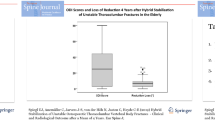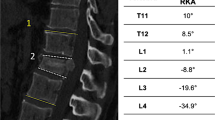Abstract
This is a retrospective study on a series of 70 patients with thoracolumbar fractures (TL), surgically treated by the in situ bending technique (ISB). Its purpose is to show the performances and limits of the ISB technique for the early correction of post-traumatic spine deformities as well as to estimate the overall outcome in this series and to discuss the indications for anterior grafting. Although the management of limbs fractures is a cleared issue today, spine fractures management is still a matter of debate. Surgical treatment progresses fast, while indications, the fixation techniques, fracture reduction options, and associated grafting are still blurry. Seventy patients with TL fractures, mean age 40.3 years (20–80) were treated by posterior fusion with a standard construct and deformity reduction by means of the ISB technique. Mean follow-up was 30.7 months (12–78). Pre- and post-operative deformity was evaluated and the relative deformity as defined by Farcy’s sagittal index (SIF) was analyzed. Thirty-eight patients underwent anterior interbody grafting. The pre-operative SIF decreased from 16.98 to 1.62° (15.36° decrease). Eighty percent of patients were normo- or hyper-corrected. The loss of correction during the follow-up occurred within the disc (SIF: −2.24°, vertebral kyphosis 0.94°, p<0.001), and was lower in patients who underwent secondary anterior grafting (−5.21° vs.–1.18°, p=0.002). Clinical outcome is good (Oswestry=29.75) and seems to be better in cases of double approach (20.71 vs. 37.,4, p=0.001). Sepsis occurred in ten cases, and two patients experienced construct dismounting. One patient had a retroperitoneal hematoma that required embolization. Seventy-one percent of operated patients went back to their previous work after surgery. Spine fractures deserve an efficient treatment. The ISB technique improves post traumatic kyphosis. This results is maintained at long term if the posterior fusion is associated with anterior grafting in cases where the correction within the disc exceeds 50% of the total correction.







Similar content being viewed by others
References
Alvine GF, Swain JM, Asher MA, Burton DC (2004) Treatment of thoracolumbar burst fractures with variable screw placement or isola instrumentation and arthrodesis. J Spinal Disord Tech 17(4):251–264
Argenson C, Puch J-M, de Peretti F, Perraud M, Cambas PM (1993) Le remodelage du canal vertébral après traitement des fractures du rachis thoracolombaire. Rev Chir Orthop 79(Suppl 1):120
Argenson C, Farcy J-P, Floman Y (1993) Thoracolumbar spine fractures. Raven Press, New York
Bastian L, Lange U, Knop Ch, Tusch G, Blauth M (2001) Evaluation of the mobility of adjacent segments after posterior thoracolumbar fixation: a biomechanical study. Eur Spine J 10:295–300
Belleberba C, Sohail KM, Chapmann JR (2004) Surgical treatment of thoracolumbar fractures-posterior approach. In: Reitman CA (ed) Management of thoracolumbar fractures, Monograph series 26. American Academy of Orthopaedic Surgeons, USA
Benson DR, Burkus JK, Montesano PX, Sutherland TB, McLain RF (1992) Unstable thoracolumbar and lumbar burst fractures treated with the AO fixateur interne. J Spinal Disord 5(3):335–343
Böstman OM, Myllynen PJ, Riska EB (1987) Unstable fractures of the thoracic and lumbar spine: the audit of an 8-year series with early reduction using Harrington instrumentation. Injury 18(3):190–195
Briem D, Linhart W, Lehmann W, Bullinger M, Schoder V, Meenen NM, Winfolf J, Rueger JM (2003) Investigation of health-related quality of life after a dorso ventral stabilization of the thoracolumbar junction. Unfallchirurgie 106:625–632
Burham R, Warren SA, Saboe LA, Davis LA, Russel GG, Reid DC (1996) Factors predicting employment one year after traumatic spine fracture. Spine 21(9):1066–1071
Cantor JB, Lebwohl NH, Garvey T et al (1993) Non operative management of stable thoracolumbar burst fractures with early ambulation and bracing. Spine 18:971–976
Carl AL, Tromanthauser SG, Roger DJ (1992) Pedicule screw instrumentation for thoracolumbar burst fractures and fracture-dislocation. Spine 17(Suppl 8):S317–S324
Chiba M, Mc Laine RF, Yerby SA, Moseley TA, Smith TS, Benson R (1996) Short-segment pedicle instrumentation: biomechanical analysis of supplemental hook fixation. Spine 21(3):288–294
Denis F (1983) The three column spine and its significance in the classification of acute thoracoumbar spine fractures. Spine 8:817–821
Donchin M (1993) Epidemiology of spinal column and cord injury. In: Floman Y, Farcy J-PC, Argenson C (eds) Thoracolumbar spine fractures. Raven Press, New York, pp 59–63
Fairbank JCT, Couper J, Davier JB (1980) The Oswestry low back pain disability questionnaire. Physiotherapy 66(8):271–73
Farcy J-PC, Weidenbaum M, Glassman SD (1990) Sagittal index in managment of thoracolumbar fractures. Spine 15(9):958–965
Fürderer S, Wenda K, Thiem N, Hachenberger R, Eysel P (2001) Traumatic intervertebral disc lesion-magnetic resonance imaging as criterion for or against intervertebral fusion. Eur Spine J 10:154–163
Holt RT, Madj ME, Castro FP (2003) The efficacy of anterior spine exposure by an orthopaedic surgeon. J Spinal Disord 5:477–486
Isomi T, Panjabi MM, Kato Y, Wang JL (2000) Radiographic parameters for evaluating neurological space in experimental thoracolumbar burst fractures. J Spinal Disord 5:404–411
Jackson RP (1996) Lumbar burst fractures: fixation with pedicle instrumentation and reduction by adjustable countoured translating axes. The text book of spinal surgery, Chap. 2. Lippincott, Philadelphia
Katonis PG, Kontakis GM, Loupasis Ga, Aligizakis AC, Christiforakis JI, Velivassakis EG (1999) Treatment of unstable thoracolumbar and lumbar spine injuries using CD instrumentation. Spine 24(22):2352–2357
Knop Ch, Fabian HK, Bastian L, Blauth M (2001) Late results of thoracolumbar fractures after posterior instrumentation and traspedicular bone grafting. Spine 26(1):88–99
Korovessis P, Baikousis A, Koureas G, Zacharatos S (2004) Correlative analysis of the results of surgical treatment of thoracolumbar injuries with long TSRH construct: is the use of pedicle screws versus hooks advantageous in the lumbar spine? J Spinal Disord Tech 3:195–205
Kuklo TR, Polyy DW, Brett DO, Zeidman SM, Chang AS, Klemme WR (1999) Measurement of thoracic and lumbar fracture kyphosis. Spine 26(1):61–66
Leferink VJM, Nijboer JMM, Zimmerman KW, Veldhuis EFM, ten Vergert EM, ten Duis HJ (2001) Thoracolumbar spinal fractures: radiological results of transpedicular fixation combined with transpedicular cancellous bone graft and posterior fusion in 183 patients. Eur Spine J 10:517–523
Leferink VJM, Nijboer JMM, Zimmerman KW, Veldhuis EFM, ten Vergert EM, ten Duis HJ (2003) Burst fracture of the thoracolumbar spine: changes of the canal during operative treatment and follow-up. Eur Spine J 12:253–260
van Loon JLM, Slot GH, Pavlov PW (1996) Anterior instrumentation of the spine in thoracic and thoracolumbar fractures: the single rod versus the double rod Slot-Zielke device. Spine 21(6):734–739
Louis CA, Gauthier VY, Louis R (1998) Posterior approach with Louis plates for fractures of the thoracolumbar and lumbar spine with and without neurological deficit. Spine 23(18):2030–2039
Magerl F, Aebi M, Getzbein SD, Harms J, Nazarian S (1994) A comprehensive classification of thoracic and lumbar injuries. Eur Spine J 3:184–201
Mc Donough PW, Davis R, Tribus C, Zdeblick TA (2004) The management of acute thoracolumbar burst fracture with anterior corporectomy and Z-plate fixation. Spine 29(17):1901–1909
Mc Lain RF, Sparling E, Benson DR (1993) Early fealure of short-segment pedicle instrumentation for thoracolumbar fracture. J Bone Joint Surg Am 75:162–167
Mc Lain RF, Benson RR (1999) Urgent surgical stabilization of spinal fractures in polytrauma patients. Spine 24(16):1646–1654
Mc Lain RF (2004) Fonctional outcomes after surgery for spinal fractures: return to work and activity. Spine 29(4):470–477
Mehta JS, Reed MR, Mc Vie JL, Sanderson PL (2004) Weight-bearing radiographs in thoracolumbar fractures. Do they influence management? Spine 29(5):564–567
Mumford J, Weinstein JN, Spratt KF, et al. (1993) Thoracolumbar burst fracture: the clinical efficacy and outcome of non operative management. Spine 18:955–970
Oner FC, van der Rijt RR, Ramos LM, Dhert WJA, Verbout AJ (1998) Changes in disc space after fractures of the thoracolumbar spine. J Bone Joint Surg Br 80-B:833–839
Parker JW, Lane JR, Karaikovic EE, Gaines RW (2000) Successful short-segment instrumentation and fusion for thoracolumbar spine fracture. Spine 25(9):1157–1169
de Perreti F, Cambas PM, Pusch JM, Nars ZG, Lovet J, Argenson C (1994) The use of the CD modular construct (2HS-1SH) for fixation of comminuted fractures of the thoracolumbar junction. A comparison with other constructs. Rev Chir Orthop 80:205–216
Reid DC, Hu R, Davis LA, Saboe LA (1988) The non operative treatment of burst fractures of the thoracolumbar junction. J Trauma 28(8):1188–1194
Reitman CA (2004) Management of thoracolumbar fractures, Monograph series, vii. American Academy of Orthopaedic Surgeons, USA
Rosencher N, Woimant G, Ozier Y (1999) Stratégie opératoire d’épargne sanguine homologue et érythropoïétine en péri-chirurgie. Transfus Clin Biol 6:370–379
Roy-Camille R, Roy-Camille M, Demeulenaere C (1970) Osteosynthèse du rachis dorsal, lombaire et lombosacré par plaques métalliques vissées dans les pedicules vertébraux et les apophyses articulaires. Presse Med 78:1447
Roy-Camille R (1986) Internal fixation of thoracolumbar spine with pedicle screw plating. Clin Orthop 203:7–17
Sasso RC, Best NM, Reilly TM, McGuire RA (2005) Anterior only stabilization of three column thoracolumbar injuries. J Spinal Disord Tech 18(Suppl):S7–14
Schultheiss M, Kinzl L, Claes L, Wilke HJ, Harting E (2003) Minimally invasive ventral spondylodesis for thoracolumbar fracture treatment: surgical technique and first clinical outcome. Eur Spine J 12:618–624
Schwatz C, Steib JP (1991) Les fractures du rachis dorsal et lombaire: table ronde du GECO. Eur J Orthop Surg 1(4):211–267
Sjostrom L, Jacobsonn O, Karlstrom G, Pech P, Raushing W (1994) Spinal canal remodelling after stabilization of thoracolumbar burst fractures. Eur Spine J 3(6):312–317
Stagnara P, De Mauroy J-C, Dran G, et al. (1982) Reciprocal angulation of vertebral bodies in a sagittal plane: approache to the references for the evaluation of kyphosis and lordosis. Spine 7:335
Steib JP (1996) Spine contouring system in lumbosacral arthrodesis. In: Margulies JY, Floman Y, Farcy JP, Neuwirth MG (eds) Lumbosacral and spinopelvic fixation. Lippincott-Raven, Philadelphia, NewYork, pp 421–30
Steib J-P, Freund J-P, Sauvey TH, Pierchon F, Lang G (1998) Spine fractures corrected by rod rotation with instrumentation 2HS-1SH. Biomechanical study. Rachis 10(4/5):175–185
Tan JS, Kwon BK, Dvorak MF, Fisher CG, Oxland TR (2004) Pedicle screw motion in osteoporic spine after augmentation with laminar hooks, sublaminar wires, or calcium phosphate cement: a comparative analysis. Spine 29(16):1723–1730
Tropiano P, Russel CH, Louis CA, Poitout DG, Louis R (2003) Functional and radiographic outcome of thoracolumbar and lumbar burst fractures managed by closed orthopaedic reduction and casting. Spine 28(21):2459–2465
Vaccaro AR, Silber JS (2001) Post-traumatic spinal deformity. Spine 26(24S):S111–S118
Yazici M, Gulman B, Sen S, Tilki K (1995) Sagittal contour restoration and canal clearance in burst fractures of the thoracolumbar junction (T12–L1): the efficacy of timing of the surgery. J Orthop Trauma 9(6):491–498
Yerbi SA, Ehteshami JR, Mc Lain RF (1997) Offset Laminar hooks decrease bending moments of pedicle screws during in situ contouring. Spine 22(4):376–381
Yosipovitch Z, Robin G, Makin M (1997) Open reduction of unstable thoracolumbar spinal injuries and fixation with Harrington rods. J Bone Joint Surg 59A:1003–1015
Waelchli B, Min K, Cathrein P, Boos N (2002) Vertebral body compression fracture after removal of pedicle screws: a report of two cases. Eur Spine J 11:504–506
Walchi B, Heini P, Berlemann U (2001) Loss of correction after dorsal stabilization of burst fracture of the thoracolumbar junction. The role of transpedicular spongiosa plasty. Unfallchirurgie 104(8):742–747
Weinstein JN, Collalto P, Lehmann TR (1988) Thoracolumbar burst fractures treated conservatively: long-term follow-up. Spine 13:33–38
Wood KB, Bohn D, Mehbod A (2005) Anterior versus posterior treatment of stable thoracolumbar burst fractures without neurologic deficit. J Spinal Disord Tech 18(S):15–23
Acknowledgment
Catherine Libessart for the translation of this paper.
Author information
Authors and Affiliations
Corresponding author
Rights and permissions
About this article
Cite this article
Steib, JP., Aoui, M., Mitulescu, A. et al. Thoracolumbar fractures surgically treated by “in situ contouring”. Eur Spine J 15, 1823–1832 (2006). https://doi.org/10.1007/s00586-006-0161-5
Received:
Revised:
Accepted:
Published:
Issue Date:
DOI: https://doi.org/10.1007/s00586-006-0161-5




